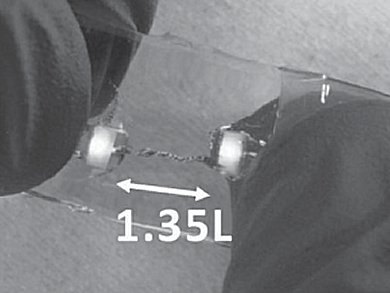Michael D. Dickey and colleagues, North Carolina State University, Raleigh, NC, USA, developed four different methods to direct write 3D, free standing, liquid metal microstructures at room temperature. They extrude the liquid metal through a capillary to clot tiny spheres of metal together. The binary eutectic alloy of gallium and indium (EGaIn, 75 % Ga 25 % In by weight) was used. However, they say that any alloy of gallium will also work.
EGaIn is liquid at room temperature with metallic conductivity. Upon exposure to air, the metal nealry instantaneously forms a thin ( ~1 nm) passivating “skin” composed of gallium oxide. Electrical resistance remains largely unaffected because the skin is thin and the liquid metal adheres to most surfaces and alloys with many metals to form ohmic contacts.The thin oxide layer on the surface of the liquid metal stabilizes the microstructures despite the low viscosity and large surface energy of the liquid. It allows for the formation of mechanically stable structures strong enough to stand against gravity and the large surface tension of the liquid. Extruded metal wires or tiny structures crafted from spheres can be created like this. The smallest components fabricated were ~10 µm. The authors assume smaller structures can also be created through, for example, the use of smaller nozzles.
The work demonstrates new methods for 3D patterning. It suggests that skin forming liquids may be used to direct-write liquids into shapes previously prohibited by the destabilizing effects of surface tension.
- 3D Printing of Free Standing Liquid Metal Microstructures,
Collin Ladd, Ju-Hee So, John Muth, Michael D. Dickey,
Adv. Mater. 2013.
DOI: 10.1002/adma.201301400




